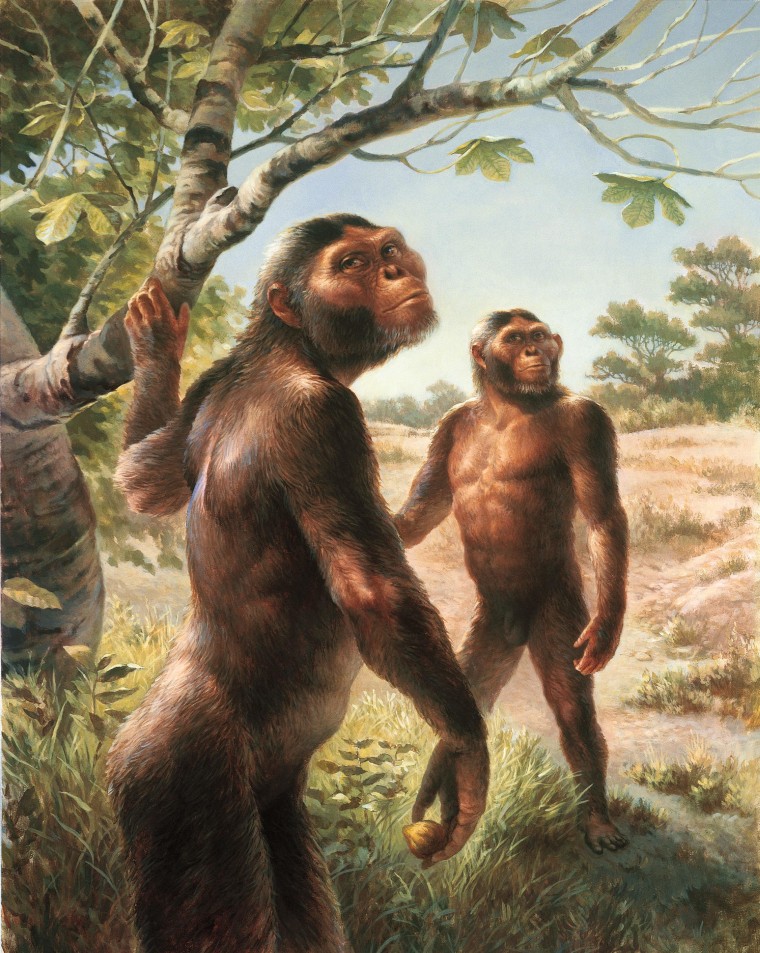Was Lucy a she? Paleoanthropologists have always visualized the famous skeleton of the human ancestor found 40 years ago as a petite female, due to the size of the bones. But now that a variety of specimens have been classified as Australopithecus afarensis, some researchers are saying it's harder than some people think to determine the sex of Lucy's kin.
"We can't really 'sex' Australopithecines," Penn State anthropologist Philip Reno said in a news release. The size variations in the long-extinct species' bones are such that scientists shouldn't always assume the smaller-sized skeletons belonged to females, Reno and Kent State evolutionary biologist C. Owen Lovejoy reported Tuesday in the open-access journal PeerJ.

Sex-related differences in size are known as sexual dimorphism: Gorillas are highly dimorphic, while humans are only moderately so. The newly published analysis, based on a study of more than 40 specimens, determined that Australopithecines were more like humans than like gorillas when it came to size differences.
Despite the uncertainties, Lovejoy said Lucy was most likely female. "The reason we know she's female is that she's the smallest of the species that's ever been found," he told NBC News.
Lucy is thought to have stood about 3-foot-6 (107 centimeters) in height. The largest specimen of the species is known as Kadanuumuu ("Big Man" in Ethiopia's Afar language), and stood as tall as 5-foot-6 (168 centimeters). "He's undoubtedly a male," Lovejoy said.
"The problem is, there's a whole host of specimens that are in the middle — and somewhere you get into a range where we just don't know," he added.
It's not always about size
Reno told NBC News that the typical way to determine the sex of human skeletons — by looking at the shape of their pelvises for childbearing — wouldn't work for Australopithecines, since they probably didn't have the birth-canal issues that humans have. (There's a debate about that, however.)
Some researchers had hoped that size would separate the males from the females, as it clearly does for gorillas. Reno and Lovejoy say that's not a reliable yardstick. "It's like saying that if you're taller than 5-foot-8, you must be a male," Lovejoy said. Reno, who says he's 5-foot-6, pointed out that "it's not uncommon to find women who are taller than me."
Other paleoanthropologists are not totally convinced.
"The contemporaneity of the First Family remains is strong vindication of sexual dimorphism," Donald Johanson, a paleoanthropologist at Arizona State University who unearthed Lucy's remains in 1974, told NBC News in an email. "If we have large afarensis and small afarensis fossils, and it is not due to sexual dimorphism, then what is the explanation?"
Johanson said the smallest specimens were most likely female, and the largest specimens were "undoubtedly male."
But he agreed with Reno and Lovejoy that the issue gets tricky somewhere in the middle: "There are certainly bones situated in the center of the normal curve that cannot be definitively placed in either sex."
This report has been revised to reflect follow-up interviews with the authors of the research paper, titled "From Lucy to Kadanuumuu: Balanced Analyses of Australopithecus Afarensis Assemblages Confirm Only Moderate Skeletal Dimorphism." Many thanks to John Hawks, a paleoanthropologist at the University of Wisconsin at Madison, for providing additional perspective.

